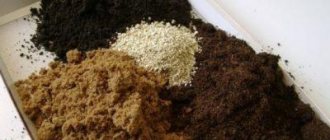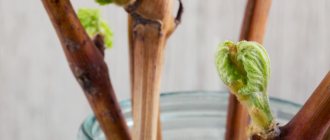Growing a flower in a potato in a pot at home
When propagating by cuttings, the following problem arises: rose cuttings are very finicky and often dry out when grown in soil, and when grown in water, they rot from lack of oxygen. So how can we ensure both oxygen access and constant humidity at the same time? It turns out that this dilemma can be solved using ordinary potatoes.
Rooting rose cuttings using potatoes is a very common method among people and the most effective. You won't regret using potatoes to plant rose cuttings. It will feed the cuttings and protect the flower from disease.
Alternative methods for rooting roses
To ensure that rose cuttings form good callus and take root normally, instead of planting them in potatoes, it is better to turn to more scientifically based methods:
| Method | Short description | Rooting percentage |
| Rooting in water | The prepared cuttings are placed in a container with water, sprayed and covered with a bag or a cut-off bottle to protect the buds from drying out. | 45-70% |
| Rooting in sand or vermiculite | Drainage is placed at the bottom of the container, a small layer of nutrient soil is poured on top, and calcined river sand or vermiculite is placed on top of it. The prepared cuttings are placed at an angle in the sand so that the cut does not come into contact with the nutrient soil. The cuttings are sprayed on top and covered to protect them from drying out. | 70-90% |
| Rooting using the “burrito” method | The newspaper sheet is well wetted with water. A layer of moistened sphagnum is laid on it. The prepared cuttings are placed on sphagnum moss and wrapped in newspaper. A plastic bag is placed on top of the package. | 85-95% |
Rooting in water, sand or the “burrito” method is more suitable for roses than planting in potatoes.
Different methods of rooting cuttings allow you to get roots at different times. Root formation occurs most quickly when cuttings using the “burrito” method - in 3 weeks with strict adherence to technology (
Pros and cons of this rooting method
Potatoes for cuttings not only create a moist environment, but also provide the nutrients necessary for growth.
After all, it contains starch, proteins and mineral salts, which are so necessary for the shoot to grow and form roots. Without a root system, the cutting is not able to take these substances on its own, but the potato supplies it with everything it needs. also serve as protection against hypothermia, drying out, and against various pests and pathogens . This is an undoubted advantage of this method. And the only drawback is that despite the developed root structure, according to statistics, approximately 15% of seedlings do not take root when transplanted to a permanent place of growth (however, the same thing happens with other methods).
How is potato planting done?
After the planting material has been processed, the roses begin to be rooted in the potatoes. Beginner gardeners are always interested in how this method differs from others widely used in gardening. The overseas root vegetable, as potatoes used to be called, is rich in nutrients that the plant needs when taking root and actively developing. Starch, proteins and mineral salts nourish the seedling and prevent it from drying out and disappearing. The vegetable also protects young plantings from the cold in winter.
Roses of pink and red shades germinate well.
In order to grow a full-fledged queen of flowers in a potato tuber, you need to select suitable specimens of the root crop. The procedure requires healthy, juicy samples without rot or other damage. Typically, medium-sized tubers are required. If you come across a large potato, then cut it in half. At the next stage, the eyes are removed from the fruit so that they do not germinate, and a recess is made to accommodate the cutting.
It is better to plant fragrant beauties from a bouquet in potatoes in the winter, so that in the spring the planting material is ready to be transferred to open ground. The finished cuttings are placed into a recess made in the root crop with a sharp end, after which the structure is moved into a small container. Expanded clay or other drainage material is poured onto the bottom of the vessel. Then they sprinkle it with soil and place the cuttings in the root crop there.
After which the vegetable is finally covered with soil so that the lower bud is not high above the surface. The soil for growing a flower in a potato is mixed with sand. It is recommended to water the seedling and cover it with a glass jar or the edge of a plastic bottle with a lid. The “dome” for protection and rooting should be wider than the plant itself so that the leaves of the seedling do not touch its walls.
Step-by-step instructions: how to plant and root a flower in a potato?
To grow a rose in potatoes, you should strictly adhere to the following algorithm for planting and rooting cuttings:
- Prepare your inventory. You can take medium-sized pots (at least 20 centimeters high) or even use plastic bottles. Divide the bottle into two parts: you can place the stem in the lower half and cover it with the upper half. Let's get a small greenhouse.
- Prepare the rose. When preparing the cuttings, consider the following: the lower cut should be made 2 centimeters below the bud at an angle of 45 degrees, and the upper cut should be 1 centimeter above the bud at a right angle (90 degrees). The length of the cutting is 20-25 cm. It is better to cut the shoot under running water, so that no air gets into the cut, using pruning shears or a sharp knife.
All thorns and leaves should be removed from the cuttings, since moisture loss occurs through the leaves. To make the cuttings germinate faster, you can put them in a biostimulator solution for a day: Kornevin, Epin, heteroauxin. If for some reason there is no biostimulator, place the cuttings in a weak manganese solution for 30 minutes.
- Prepare the potatoes. Large or medium-sized tubers are suitable, without damage or signs of disease. If the potatoes have eyes, remove them to prevent sprouting.
- Plant potatoes with cuttings. Burn the sections of the cuttings with a solution of potassium permanganate and stick the cutting into the potato, approximately to the middle.
Place drainage at the bottom of the pot (you can take small pebbles), and sand on top - 3-5 centimeters thick. Place a potato with a cutting there, cover it with humus or soil mixture, any store-bought flower mixture will do. Humus should be disinfected in advance by 2-3 freezes in the freezer for 2-3 days. From time to time, microflora restorers - Fitosporin or Baikal M-1 - should be added to the soil. - Create a greenhouse effect. To maintain heat and humidity, a greenhouse effect should be created: if the cutting is planted in a pot, it should be covered with a jar, but if in plastic, then with the top of a plastic bottle. Place the pot with the plant in a place where there is a lot of light, but there is no direct sunlight.
- Waiting for the result. Now all that remains is to look forward to the result. How can you tell if a cutting has roots? After about 10-15 days, you need to carefully pull out the plant; if it comes out easily, it means it has not yet taken root. It should be reinstalled and the test repeated after a week.
Preparatory stage
To germinate rose cuttings in potatoes at home, you need to prepare the tubers and the cuttings themselves. A rose from a bouquet will take root in the garden only if it has not yet bloomed. Otherwise, the probability of a positive outcome is quite small. Also, pay attention to the thickness of the rose stem - a flower that is too thin may not take root, so choose stems thicker than 0.5 mm.
Potatoes act as a nutrient substrate for the flower - they transfer accumulated nutrients and saturate the flower with the necessary moisture.
- Remove leaves and thorns from the stem;
- Cut off the top with sharp pruners or scissors. Be sure not to crush the stem while pruning. The lower cut should be made at an angle of 45º, and the upper cut should be strictly straight;
- Divide the cutting into several parts - you can grow several bushes from one flower, the main thing when dividing is to leave at least 3 buds on each part of the cutting;
- Place the roses in the biostimulator. If there is no specialized product, then you can make it yourself from aloe or honey (a tablespoon of honey per glass of water). Or place the flowers in a solution of potassium permanganate. The cuttings should be kept in the nutrient solution for at least 2 hours;
- Cauterize the cuttings with a solution of potassium permanganate.
At this point, the preparation of the cuttings is completed, and you can start growing potatoes. Potato tubers should be large in size, without signs of disease or cuts. It is important to remove all the eyes from the tubers, otherwise the potatoes will sprout and may “smother” the flower. Next, you should stick the cuttings into the potatoes, piercing each tuber approximately to the middle. The blanks are ready for planting in the ground. Now the nutrients from the potato will saturate the rose, and the flower will grow faster.
Further care
A necessary condition for rooting cuttings is maintaining constant soil moisture. Watering should be done regularly, but not very intensively. In addition to watering, you should constantly spray the cuttings with water at home temperature. To give the plant additional nutrition, once a week you can water it with a sugar solution: half a glass of sugar for 0.5 liters of water.
The cutting also needs good lighting, an abundance of sunlight will help the cutting grow into a full-fledged flower, you just need to make sure that the sprouts do not overheat. After the buds appear, the shelter should be removed, first for a short time, then increasing the ventilation time, gradually adapting the rose to environmental conditions. After one or two weeks, the caps are finally removed. After this, you should water the rose every day.
Difficulties and ways to solve them
Successful cuttings of roses do not require large material costs, but certain theoretical knowledge is required. To avoid difficulties and get excellent results, novice rose growers can use the following tips:
Well, we have become familiar with all the nuances of growing roses from cuttings at home. To increase the likelihood of breeding a rose, it is better to root several cuttings at the same time.
If you don’t succeed right away, don’t despair, keep experimenting, everything will certainly work out. But the beautiful flower obtained as a result of your labors will delight us for years with its divine appearance and incomparable aroma. In addition, it will become a reliable amulet for your family nest, will take away all the negative energy and give you good luck in all your endeavors.
The nuances of transplanting to a permanent place
Planting roses with cuttings in potatoes is not an easy task, but the most difficult thing is not just to root the cuttings, but to preserve the flower after planting it in a permanent place. Therefore, it is important to plant in early autumn: over the summer the cuttings will take root, and in the fall they will have time to prepare for wintering in a new place.
Closer to winter, when night temperatures reach 5º, it is necessary to cover roses. It is best to make protection from pine branches.
Unfortunately, in the spring, it is sometimes discovered that despite all the precautions taken, the flower still turns black. Take your time to dig, sometimes, after a hard winter, a rose needs several months to come to its senses. And by mid-summer, it can come to life and delight you with flowering. So if you find yourself in such an unpleasant situation, do not rush to judge the flower, but rather be patient. If the flower does not come to life by autumn, feel free to dig it up.
“How to grow a rose from cuttings in potatoes” is a process that is both simple and complex at the same time, depending on many factors, from the quality of the rose from the bouquet to the weather outside the window. Don’t be upset if you didn’t succeed in growing a flower the first time. Growing such a noble plant is an art. Therefore, do not give up, but rather try to grow roses again next year.
Propagation of roses by cuttings at home
Flower growers have made several attempts to propagate such chic and popular flowers as roses from cuttings. However, only a small part of them were successful. Below we will describe several ways to propagate roses using cuttings, and if you follow fairly simple rules, you can quite succeed. This method of propagation is considered the most successful compared to seed and grafting. The fact is that it is relatively simple, and it can be used either in the warm or in the cold season. Because you can take cuttings not only directly from a rose bush, but also use those that were given to you as a bouquet.
How to grow a rose from a cutting
Several ways
So, several completely different methods are used for cutting roses:
- Trannois method;
- Burrito way;
- rooting using a container filled with water;
- rooting in a potato tuber;
- rooting in a package;
- planting cuttings in open ground in the summer;
- rooting cuttings in the cold season.
The most natural method of rooting is summer in open ground. It is recommended to cut cuttings in the morning or evening hours. Semi-lignified stems that have only recently stopped blooming or are just beginning to bloom are best suited. The main sign that a shoot is suitable for cuttings is when the thorns can be broken off quite easily. For cutting you need to use a very sharp, pre-sterilized knife. The length of the cuttings varies from 12 to 15 centimeters, and each of them should have 2 or 3 leaves and the same number of buds. But there shouldn't be any flowers. The cut should be oblique. It is made directly under the node located below, and also 15–20 millimeters above the upper node. All lower leaf plates, as well as thorns, must be torn off. In order to retain moisture as long as possible, experts advise either removing the remaining leaves or shortening them, leaving 1/3 of them. To speed up rooting and make it more successful, you need to dip the lower part of the cuttings into a solution that stimulates root formation (kornevin or heteroauxin) and wait a while. You can also use a mixture consisting of ½ part of a small spoon of bee honey, 200 g of water and several crushed rose leaves as a root growth stimulator.
Caring for rose cuttings
Rooting of cuttings can be done directly in open ground. For planting, you will need a substrate consisting of nutrient-rich soil and coarse washed river sand. Prepare the holes by watering them with a steep solution of potassium manganese. The cuttings should be planted in the ground at an angle of 45 degrees, with the bud located at the very bottom should be in the ground. After this, the cuttings need to be watered and covered on top with separate glass jars. If during the day the temperature remains at least 25 degrees, and at night at least 18 degrees, then the cutting will take root after about 4 weeks, and a young shoot will appear from the bud. After half a month, you need to start hardening the plants. To do this, it is necessary to remove the shelter every day, and after some time, return it again. After a few days of hardening, the shelter should be removed for good. By the onset of autumn, the plant will reach a height of 30–40 centimeters. The buds that appear should be removed, since all the forces of a young rose should go towards the formation and growth of roots. This is the general principle of cutting roses.
In autumn, it is recommended to carefully dig up young plants and place them together with a lump of soil in a cellar for storage throughout the winter. If desired, the dug rose can be planted in a pot and placed in the house in a well-lit, cool place until the onset of spring.
Rooting rose cuttings in potatoes
You can root cuttings of this plant in a potato tuber. To do this, in the spring, a trench is dug, the depth of which should be about 15 centimeters. A place for it should be chosen that is sunny and protected from gusts of wind. A five-centimeter layer of sand should be poured onto the bottom. Prepare cuttings, the length of which should be approximately 20 centimeters. You need to tear off all the leaves and thorns from them. All eyes must be cut out from a medium-sized young potato tuber. Stick the prepared cutting into the potato and lower it into the trench. Bury to 2/3 of the length, while the distance between the cuttings should be about 15 centimeters. In the first days, the cuttings should be covered with glass jars. The success of such rooting lies in the fact that the part of the cutting inserted into the tuber is in a constantly moist environment, and the plant is also saturated with starch and healthy carbohydrates. This method is the most popular. Provide the plants with systematic watering. At the same time, once every 5 days they need to be watered with sweetened water, so for 200 g of water take 2 small spoons of granulated sugar. After half a month, begin to harden off young roses, removing the shelter for a while. After half a month, the shelter is removed for good.
When is the best time to root a rose?
To propagate roses from cuttings in a potato tuber, experienced gardeners choose the spring months, depending on climatic conditions. It is necessary to catch the period when the leaves have begun to grow, but the flower buds have not yet appeared or have just hatched. Cuttings from such a bush are the strongest and take root better.
If necessary, you can use this growing technology throughout the warm season. But at the same time, one should take into account the need to root young seedlings before the onset of cold weather. After the end of June, cuttings are rarely carried out, when planting for the winter in heated rooms or greenhouses.
Roses from bouquet cuttings
Rooting rose cuttings from a bouquet is also quite popular. But it is worth considering that for this it is necessary to use domestic flowers, not imported ones. And that’s all, because before imported flowers are sent to Russia, they are treated with special chemicals that have a preservative effect, and therefore the cuttings are not capable of forming a root system. Some tips:
- For rooting, use cuttings only from a fresh bouquet.
- The shoot must be a little woody.
- The cuttings should have medium thickness and buds located at the very top and bottom (the cuttings are cut in the same way as described above).
Roses from a bouquet should be rooted as quickly as possible. This means that if you were given a bouquet, you should donate it immediately. To do this, you need to tear off all existing flowers and buds. The length of the cuttings can vary from 15 to 30 centimeters. All leaf plates from below must be torn off, and those on top must be shortened by 2/3 of their length. The prepared cuttings are placed in a vase filled with distilled water. Next, you need to systematically replace the water until the first roots appear. After this, the cuttings should be planted in a pot in the cold season, and in open ground in the warm season. Cover them with a glass jar.
Which roses are suitable for cuttings
Not all roses are suitable for propagation by cuttings. To successfully plant a rose from a bouquet or cut from a bush in potatoes, you need to take into account a number of nuances:
- Climbing and groundcover varieties of roses are not suitable for cuttings;
- you need to use only strong stems with living buds and leaves, the thickness of which exceeds 0.5 cm;
- cuttings from stems with ripe buds and blossoming flowers take root very difficult, so it is better to choose shoots that have not yet bloomed;
- The largest percentage of rooted sprouts are produced by mature stems with easily broken off thorns.
It must be remembered that sluggish, dried out shoots affected by fungus are unsuitable for propagation and cultivation.
Comment! A cutting is a part of a rose stem with several living buds, 15 to 25 cm long.
Roses with straight stems that are not affected by pests or diseases are suitable for cuttings.
Other methods of cutting roses
Cuttings in a package
Prepared rose cuttings must be placed in a bag into which a sterilized substrate or sphagnum moistened in a solution of aloe juice (1 part juice and 9 parts water) is first poured. Then the bag should be inflated and tied well. It needs to be hung on the window. Due to the high humidity, a kind of fog forms inside the bag, and after about 4 weeks the first roots appear on the cuttings. Then they need to be planted, as described above.
Planting cuttings before winter
This method is used to preserve cuttings until the onset of spring. As the weather warms up, they can take root and begin to grow. The idea is that the cuttings will not take root until spring and will remain alive. The fact is that it is not always convenient to store cuttings indoors all winter. And sometimes it is in the autumn that truly unique varieties of roses come across. To do this, you need to dig the cutting into the soil. And in order to protect from winter frosts, a dry shelter must be placed on top. In spring, transplant the cutting to its usual place.
Burrito Method
This method is quite ineffective, but it is still quite popular among gardeners. The lower part of the prepared cuttings must be treated with a means that stimulates the formation of roots (epin or kornevin). After this, the cuttings should be wrapped in moistened newsprint and placed in a dark, cool (15 to 18 degrees) place for half a month. And after this period, roots should form on the cuttings.
Trannoy method
The point of this method is that before cutting the shoots into cuttings, they can absorb the maximum amount of starch from the leaves. As a result, they will become more stable and strong. Experts advise that after the main wave of flowering is completed (usually in June or July), you need to select suitable shoots and cut off the upper part of them with a fading flower and 2 small leaf blades. After the buds swell at the bottom of these shoots, you need to cut them into cuttings. This must be done in a fairly short time, without waiting for young leaves to appear from the buds. Cuttings should be cut as described above. Their length should be 20 centimeters, and they need to tear off all the leaves, leaving only the top 2. Such cuttings should be immediately planted in open ground at an angle of 45 degrees. It is recommended to plant several cuttings in one hole. 5-liter plastic bottles are used as shelter, the upper narrow part of which should be cut off. They are not removed until the onset of winter, even if leaves and young shoots begin to grow. The cuttings should be provided with systematic watering, as well as loosening the soil.
Description of the method of growing roses
Potatoes and cuttings prepared in advance can be planted only after you have fulfilled all the requirements and followed the necessary instructions. Next, take the tuber and make a small hole in it. A large nail or wide screwdriver is ideal. After you have completed this procedure, you can place the cutting inside the potato. Do this carefully so as not to damage its surface.
Rooting a rose after potatoes
Every gardener asked himself the question of how to grow a rose in potatoes at home. This is quite simple to do and this method will be most effective. By doing this, you will have the opportunity to regulate the level of sunlight, humidity levels and temperature conditions. This will help the plant to be quite comfortable and, as a result, it will grow and take root intensively.
To plant roses in potatoes at home, prepare tubers and cuttings in advance and combine them. Also take care of the container where they will be placed next. Preference is given to large, shallow containers that can accommodate several shoots. Place the prepared soil inside such a container; it is best to choose loose, light varieties of soil.
Popular: Proper use of ash as plant fertilizer
Having placed a potato tuber with a stalk inside, pour it with plenty of liquid and place it in a well-lit place. Make sure that it is not exposed to direct sunlight, as it can harm your plant. The optimal temperature for growing will be approximately 25 degrees Celsius. Roses are not picky about the level of humidity indoors, so do not add additional moisture.
Rooting roses in open ground
To grow roses directly in open ground, it is also important to follow several points. The most important of them will be determining the landing site. Stay in a well-lit area where it won't be too hot. It is optimal to find the rose even in partial shade.
Rooting a rose in potatoes occurs in several stages; after you have chosen a planting site, proceed to the next step. Having connected the tuber with the cutting, place it in a pre-dug hole. It should be at least five centimeters deep, the distance between each is about 10-15 centimeters.
Once you have placed the potatoes in the holes, gently sprinkle them with a small amount of soil. After completing all the necessary procedures, water the roses with plenty of liquid. During the onset of cold weather, do not forget to insulate your plant. To do this, use a thick material that can be used to cover the top of the roses. After the cold weather stops, remove this covering.
Rooting roses from a bouquet
Rooting a rose from a bouquet in potatoes is not easy, since usually all varieties in the store are treated with solutions. These are mixtures that help flowers last longer, but they can hinder their growth. Therefore, if you decide to grow them this way, be prepared for the fact that it will take you quite a lot of effort and time.
Not all roses are suitable for planting; try to choose ones that are well preserved and have a fresh look. They need to be freed from all leaves and cut so that the length of each cutting is about ten centimeters. Once you've done this, treat the stems with a solution of warm, soapy water to remove any dusting.
Then make a hole in the potato and place the cutting inside. Be prepared for the fact that this method does not always guarantee successful cultivation and it is not your fault. The problem is that stores often sell imported flowers, which are quite difficult to grow in our country.
Popular: How to recognize and protect rotting orchid roots
Features of the method
This method of growing cuttings has its own characteristics. It has proven itself well as a way to obtain a rose seedling from a given bouquet. Of course, it is not suitable for imported varieties, since they undergo lengthy transportation and chemical processing. But for growing domestic roses that have already been acclimatized, it is quite suitable.
Using a potato tuber allows the plant to receive a sufficient amount of moisture, as well as micro- and macronutrients.
Advantages and disadvantages of the method
Like any other rooting method, growing a rose from a cutting in a potato has positive and negative aspects.
The advantages of the method include:
- simplicity of the technological process;
- the ability to root even a flower from a presented bouquet;
- the rose receives excellent levels of moisture, oxygen and nutritional components from potatoes;
- the tuber will protect the plant from negative factors.
Using potatoes prevents damage to the future seedling. For example, when planted directly in the ground, it can dry out, and when germinated in water, it can rot.
The disadvantages of this method include:
- the method cannot be used for all types of roses; it is not suitable for propagating climbing varieties;
- Only plants with straight stems can be used;
- after transplantation to a permanent place, 15% of plants die, despite a developed root system;
- There are high requirements for the planting site (no drafts and direct sunlight, nutritious soil)
Caring for cuttings
Propagating roses from cuttings in potatoes is a rather labor-intensive process that requires care and attention. Therefore, carefully study all the intricacies of caring for this method. Experienced gardeners recommend covering newly transplanted cuttings with a jar. This is done to create some kind of greenhouse effect for the flowers. Inside it, the optimum temperature is maintained, which is necessary for intensive growth.
Also, high humidity is maintained there, which is important in the initial stages of rose growth. Once you see leaves beginning to appear on each cutting, you can remove the top cover. Even if you grow roses indoors, don’t be too lazy to take the containers with them outside. Do this in the warm season, when the sun is not too hot outside. This is done so that the plants have the opportunity to get enough oxygen they need.
When they reach a height of 20 centimeters or more, it is recommended to plant roses separately. Experienced gardeners recommend not letting your flowers bloom in the first year. That is, it is best to cut off all the buds that appear on young roses.
This is due to the fact that when flowering, the plant spends a lot of its energy and nutrients on this event. This ensures that all the necessary resources are used to ensure that the buds grow. That is, therefore, stop the development of the root system, since at this moment, all attention is given to flowering. Therefore, do not let your young roses bloom, but rather allow the roots to develop and grow. Next year, thanks to these actions, you will get strong plants and quite beautiful flowers.
Preparing a rose cutting and a potato tuber
Open ground and a home windowsill are suitable for growing. The success of the event largely depends on the choice of quality material, adherence to technology and proper preparation and implementation of the procedure.
The gardener needs to pay close attention to the preparatory stage. It should include the selection and preparation of potato tubers and rose cuttings, selection and processing of tools and potting containers.
Which potatoes to choose
The choice of potato also determines the success of the entire manipulation, since it becomes a storehouse of nutrients. The main requirement for a vegetable is freshness. Large tubers that are free of damage and disease are selected for planting. Next you should remove all the eyes. Otherwise, the vegetable will begin to sprout and take away nutrition and moisture from the cuttings.
How to choose the right cuttings
The stem of an unblown flower is suitable for cuttings. Its thickness should be more than 0.5 cm. After selection, the plant must go through the stage of preparation and processing. Thorns and leaves are removed from it so that they do not take food on themselves. The top of the stem is cut at a right angle, and the bottom is cut at a slope of 45 degrees. For pruning, it is better to use sharp pruners or scissors so as not to crush the stem.
To obtain a good cutting, use the following scheme: the upper cut should be 1 cm above the last bud, the lower cut should be 2 cm after it. The optimal number of rudiments on a cutting is 3-4 pcs. The length of the cutting should be no more than 15-20 cm.
Processing cuttings
After preparation, the plant should be treated with biostimulants. Specialized stores offer a large selection of various drugs, the most popular of which are “Kornerost”, “Kornevin” and “Gumisol-N”. The following folk methods are used:
- 1 tablespoon honey;
- a weak solution of potassium permanganate in which the plant is placed;
- 2 teaspoons of aloe juice, kept in the refrigerator for at least 24 hours;
- 1 teaspoon of wood ash.
The components are mixed with settled water at room temperature. The cuttings are kept in stimulants for at least 6 hours.
Inventory preparation
The following tools will be useful for planting roses:
If you have decided to plant a rose in a potato pot, then you should also be careful about your choice. Medium-sized containers or plastic bottles with cut off necks work well. As preparation, the vessels are treated with steam or boiling water. After which a five-centimeter layer of drainage is poured onto the bottom.
Recommendations
Experienced gardeners have their own secrets that allow them to successfully cut roses in potatoes:
- you can add a teaspoon of aloe juice to the potassium permanganate solution in which the cuttings are processed;
- to make a hole in the tuber, you can take a thick nail or screwdriver;
- The cuttings should be inserted into the potatoes carefully so as not to damage them;
- the optimal temperature for rose seedlings is 25 degrees, air humidity is normal;
- You should not “flood” the plantings - roses cannot tolerate waterlogging and begin to get sick.
Cuttings grown at home or in a greenhouse must be accustomed to the open air. To do this, containers with seedlings need to be taken outside, increasing the time spent gradually. With the right approach, the cuttings are finally ready for transplanting into open ground after 60 days.
Rooting rose cuttings in potatoes
If germination is carried out in autumn or winter, then you should select containers or pots for future seedlings. In spring or summer, plants can be immediately planted in open ground. To speed up rooting, you can create a small greenhouse effect. To do this, cover with cut plastic bottles.
Pot and soil
In order for the rooting of the cutting to be successful, attention should be paid to the condition of the soil. Many stores offer ready-made soil mixture for roses. This is very convenient because it is already enriched with all the necessary useful elements.
It is also possible to select land from a garden or summer cottage plot. Mineral fertilizer and humus should be added to such soil. As a disinfectant, you can freeze the soil for several days, after which it is defrosted. To restore soil microflora, the drug “Fitosporin” or a similar product is well suited.
For disinfection, you can also use a pale pink solution of potassium permanganate. After preparing the substrate and the pot, which is also recommended to be disinfected, drainage is placed at the bottom of the container, then a layer of sand and earth. After this, you can plant the rose in potatoes.
After undergoing preparatory treatment, the cutting is stuck at a sharp angle into the potato. There is no need to pierce the tuber all the way through; it will be enough to leave the edge of the plant in the middle of the vegetable. One potato is intended for one seedling.
Next, the union is placed in a container with prepared soil. If rooting is carried out directly in open ground, then 2/3 of peat mixed with fertile soil is placed in a dug trench. Sand is poured on top, which will not allow excess moisture to accumulate. The planting procedure is carried out in the morning or evening.
Creating a greenhouse effect
The use of glass or plastic containers to cover the sprouts brings the development conditions closer to greenhouse conditions. This allows you to maintain a sufficient level of soil moisture.
The improvised greenhouse can be removed after the buds begin to grow. Before this, it is allowed to open the seedlings slightly for ventilation for short periods of time. Actions are recommended to be carried out a week after planting.
Waiting for the result
Many gardeners, having figured out the question of how to root a rose in a potato, count the days when they can enjoy the result. If the seedling has been treated with biostimulants, the first appearance of roots can be expected after 14-20 days. True roots appear approximately 4-5 weeks after planting.
Most often, gardeners receive a new plant within one season (sometimes two). This is achieved by observing all agrotechnical rules.
Possible difficulties and ways to solve them
According to statistics, 15% of cuttings do not undergo the rooting process. This is associated with certain difficulties. The most common of them:
- The sprout has rotted. This is due to excess moisture in the pot or trench. You can try renewing the lower cut and placing the plant back into the tuber.
- Rooting does not occur. May be caused by unsuitable soil or rose variety. For example, climbing varieties do not take root in potatoes. The technology of care may also have been violated.
- Blackening of the cuttings. Most likely, the plant is infected. If the blackness has spread throughout the plant, then it cannot be saved. If green parts remain, the rose is treated with copper sulfate (5% solution).
Further care
Seedlings should receive good lighting, but without direct sunlight. The optimal temperature for growth is + 22…+ 24 degrees. Moderate watering is combined with spraying. Water is used that has been settled and at room temperature. It is important to ensure there are no drafts.
Growing roses in potatoes is not difficult. In addition to choosing good planting material, treatment with growth stimulants and proper planting are required. Do not forget that seedlings need careful care. In 1-2 seasons you can get a young, strong plant. The method is suitable for growing roses both in a summer cottage and in an apartment.
Sources:
https://selo.guru/rastenievodstvo/derorativ/komnatnye-rozy/kak-razmnozhit-doma/iz-cherenkov-v-kartoshke.html https://rastenievod.com/cherenkovanie-roz.html https://dachamechty. ru/tsvety/roza/kak-vyrastit-v-kartoshke.html
Related article: Folk remedies for late blight in tomatoes and potatoes - review
Fertilizer selection
Do not forget that when propagating roses in potatoes, they need fertilizers. Although the tubers have a large number of useful microelements, the flower still needs additional feeding. For this purpose, fertilizer is used with universal mineral substances, which are applied directly under the stem. However, do not do this too often, since the potato rose does not need intensive feeding. It is also recommended to add substances to the soil that prevent the appearance of fungus. You can buy them at a gardening store.
Currently reading:
- Description of 12 types of late cabbage varieties for planting
- Proper cultivation of Adenium succulent with your own hands
- Top 4 Types of Best Green Asplenium House Ferns
- Varieties of scrub roses with care and pruning
Share the news on social networks
About the author: Lyudmila Vasilievna Nosikova
Agronomist of the state agricultural enterprise "Garovskoe" of the Khabarovsk region of the Khabarovsk Territory.











